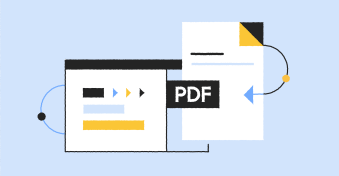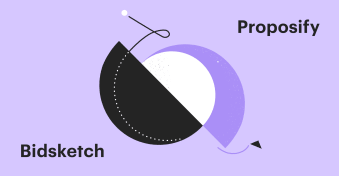Looking for Proposify alternatives?
Proposify was established back in 2013 and has proven itself as a strong and resilient player in the proposal management software niche.
Currently, the platform features:
- Legally binding electronic signatures.
- Robust proposal design tools.
- Automated follow-ups and notifications.
- Deep document analytics and insights.
- Team management and collaboration tools.
- CRM and productivity integrations.
- Industry-leading document encryption and security.
This collection of features has made Proposify one of the most prominent (and scalable!) online signature solutions.
In this guide, we’ll talk you through a number of Proposify alternatives, what they have to offer, where they differ, and how they measure up.
Let’s get started.
Quick note: Generally, we view RFP response solutions like RFPIO and Loopio as a separate category for proposal software, so we’ve excluded them from this list.
Key takeaways
- Proposify provides a robust document editor that is unmatched by most competitors. Only PandaDoc, Qwilr, and Oneflow provide a similar experience.
- Proposify falls short in areas around automation, integration, and streamlining. While it’s possible to account for this with integrations, the software is highly specialized to do one thing well.
- Proposify’s restrictions around document opens make it a weaker contender in a market where competitors offer a wide range of solutions and few transactional limitations.
1. PandaDoc
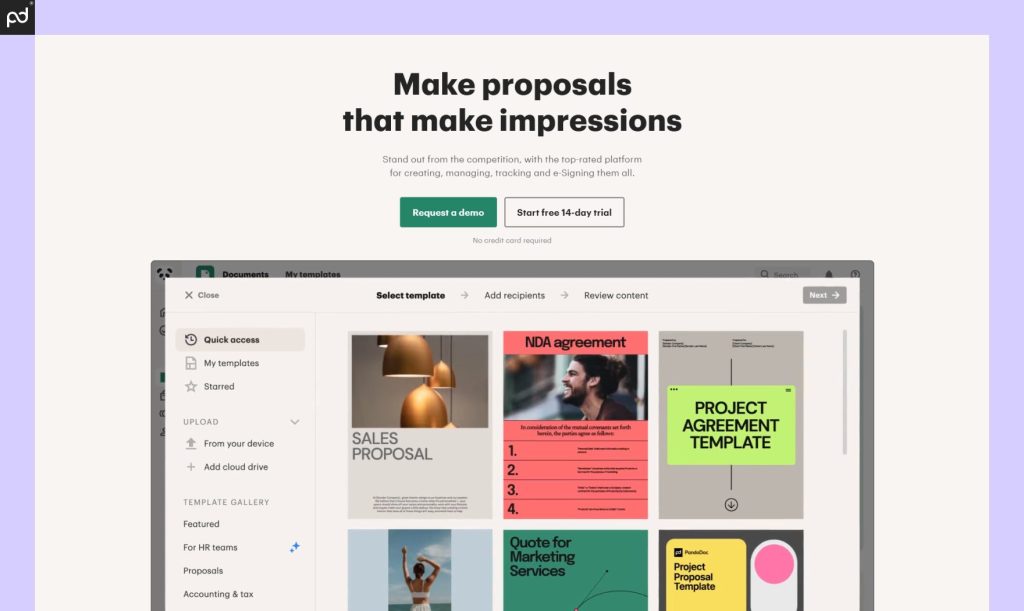
Our rating: 4.8/5
Pricing: Essentials ($19/month); Business ($49/month); Enterprise plans also available. Pricing based on annual commitment.
Free trial? Yes; 14 days.
Great fit for: Businesses and teams looking to automate and scale their document workflow.
PandaDoc is an all-in-one, cloud-based document solution created to automate contract and tracking processes, ensure secure collaboration, and provide proper document management.
This platform provides an end-to-end contract management solution, from document creation to e-signature capture, storage, and renewal.
With PandaDoc, it’s possible to upload any type of document and fold them seamlessly into your document workflow.
Word files are editable within the PandaDoc editor, while PDFs can be prepared for e-signing using drag-and-drop preparation tools.
Media files can also be incorporated into the content library for reuse across a variety of documents and templates.
| Feature | Proposify | PandaDoc |
|---|---|---|
| Proposal tools | Drag & drop | Drag & drop |
| E-signing | ✓ | ✓ |
| Templates | ✓ | ✓ |
| Content library | ✓ | ✓ |
| Custom domain | ✓ | X |
| Custom branding | ✓ | ✓ |
| Payment gateways | Limited | ✓ |
| CRM integrations | 2 | 15+ |
| Document analytics | ✓ | ✓ |
| API access | X | $ |
| Customer Support | ||
| Email / ticketing | ✓ | ✓ |
| 24/7 chat | X | ✓ |
| Phone | $ | $ |
| Success manager | $ | $ |
| Onboarding services | $ | $ |
Major differences
- PandaDoc offers a greater selection of integration options when compared to Proposify.
- Overall, the Proposify editor provides more granularity for proposal design, but it’s too much for most sales reps.
- Proposify’s Enterprise plan, which is the only way to access their Salesforce integration, carries a 10-seat minimum requirement.
Proposify vs PandaDoc
While PandaDoc and Proposify are similar in several ways, there are a few key differences.
PandaDoc is a multi-functional contract lifecycle management software with an assortment of options available to efficiently manage contracts and other business documents.
Much like Proposify, PandaDoc software allows you to build documents entirely from scratch using an in-app editor.
After the documents are shared, the platform becomes a central meeting place where stakeholders can review, negotiate, customize, and sign contracts and proposals.
Both platforms allow teams to leverage analytics and tracking to gather detailed insights about their contracts, expenditures, and revenue over time.
Data is protected using industry-leading security protocols that are compliant with GDPR, HIPAA, SOC2 Type 2 standards.
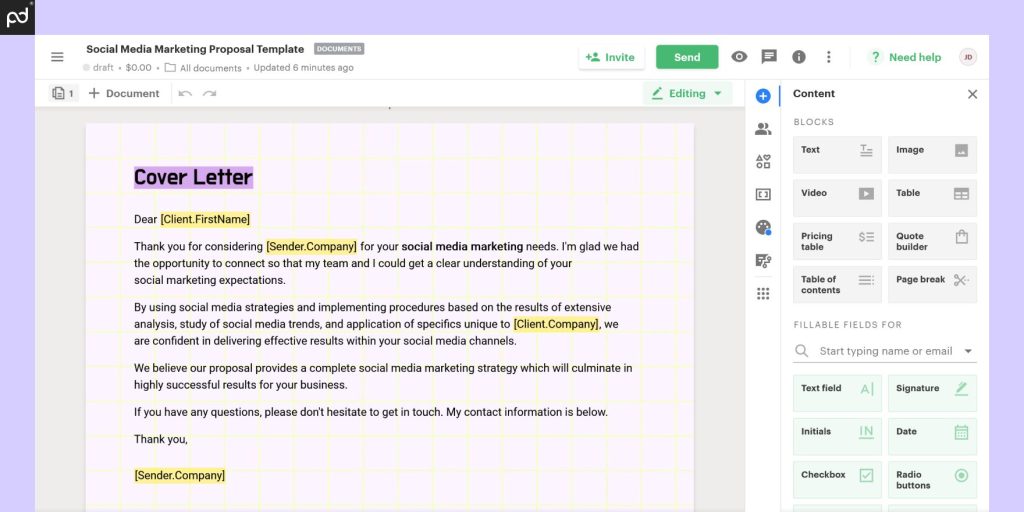
When it comes to teams, PandaDoc offers customizable user management, including a flexible approval process, multiple account roles, templating tools for faster sending, and more. Proposify also includes many of these tools, so account owners and managers will feel comfortable when transitioning between platforms.
In our view, PandaDoc begins to shine when factoring for versatility.
For example, both platforms allow users to collect payments via a payment gateway.
But, with Proposify, you can only use Stripe for that. PandaDoc provides multiple payment integration options, including Stripe, PayPal, and Authorize.net.
The same is true for workflow automations, as well as the ability to fold PandaDoc into your existing workflow.
Unlike Proposify, PandaDoc also provides API solutions so that developers can adapt PandaDoc features into the tools and software applications that your team regularly uses.
For many teams, the combination of project management and document design tools make PandaDoc the perfect alternative to Proposify.
2. Qwilr
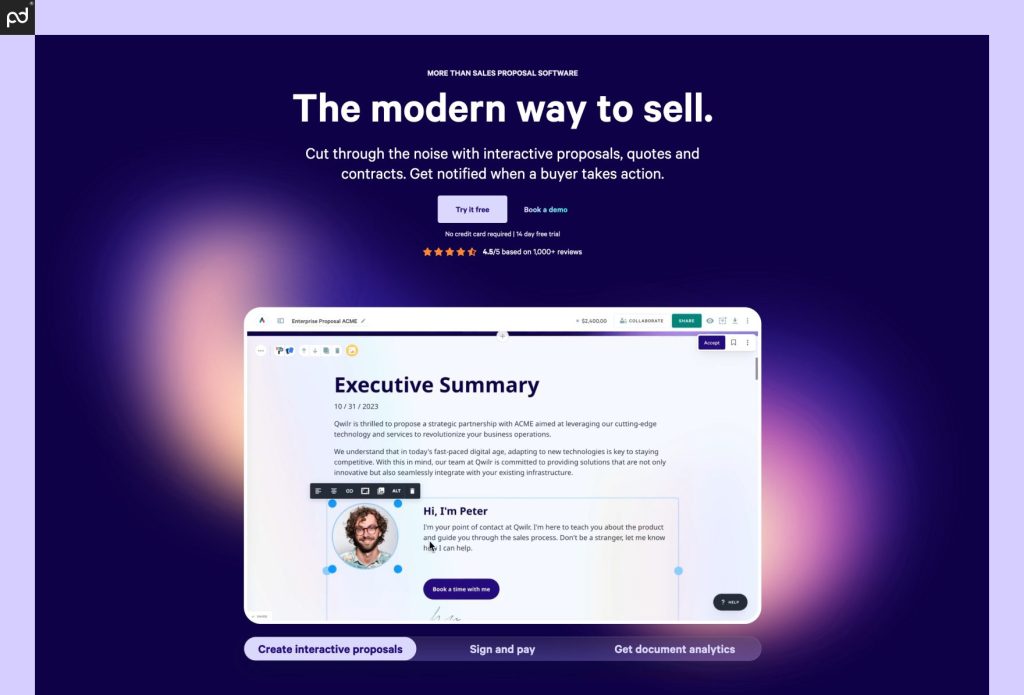
Our rating: 4.5/5
Pricing: Business ($35/month); Enterprise ($59/month with 5-seat minimum). Pricing based on annual commitment.
Free trial? Yes; 14 days.
Great fit for: Teams who want to bring the look and feel of innovative web design to their document process.
Qwilr takes a unique approach to proposal design by aiming to create a sales experience that closely resembles a website landing page.
This change creates a departure from a traditional sales document, allowing teams to give their sales proposals and contracts a look and feel that is difficult to replicate in other software tools.
The platform features a content editor and dynamic pricing tables to assist with document design.
At the enterprise level, you can also use custom domains and import data with Salesforce integrations.
The Qwilr approach can still integrate well with a standard sales process while giving your sales experience a facelift that customers will remember when faced with piles of same-old proposal documents.
| Feature | Proposify | Qwilr |
|---|---|---|
| Proposal tools | Drag & drop | Drag & drop |
| E-signing | ✓ | ✓ |
| Templates | ✓ | ✓ |
| Content library | ✓ | ✓ |
| Custom domain | ✓ | ✓ |
| Custom branding | ✓ | ✓ |
| Payment gateways | Limited | ✓ |
| CRM integrations | 2 | 4 |
| Document analytics | ✓ | ✓ |
| API access | X | $ |
| Customer Support | ||
| Email / ticketing | ✓ | ✓ |
| 24/7 chat | X | $ |
| Phone | $ | X |
| Success manager | $ | $ |
| Onboarding services | $ | $ |
Major differences
- Qwilr’s editor feels more like a website builder than a document builder, and the outputs reflect this change.
- Though both brands offer custom domains / branded URLs, Qwilr’s e-signing experience more closely resembles an actual web page.
- Proposify’s enterprise plans require a 10-seat minimum while Qwilr’s enterprise solution requires five.
Proposify vs Qwilr
Unlike Proposify and most of its software rivals, Qwilr’s primary focus isn’t on creating sales documents. (Check out Qwilr’s primary competitors right here.)
Instead, Qwilr produces a fully interactive web page once you’re done designing your business proposals, bringing something entirely new to the table.
The pages are mobile-responsive (no mobile app required!) and include numerous pieces of embedded content, including video, dynamic pricing tables, and Google Maps.
Compared to Proposify, the platform provides an entirely different output that fills a very similar role. Even with Proposify’s flexible design tools, the end-result will still be a proposal document. With Qwilr, it’s a web page.
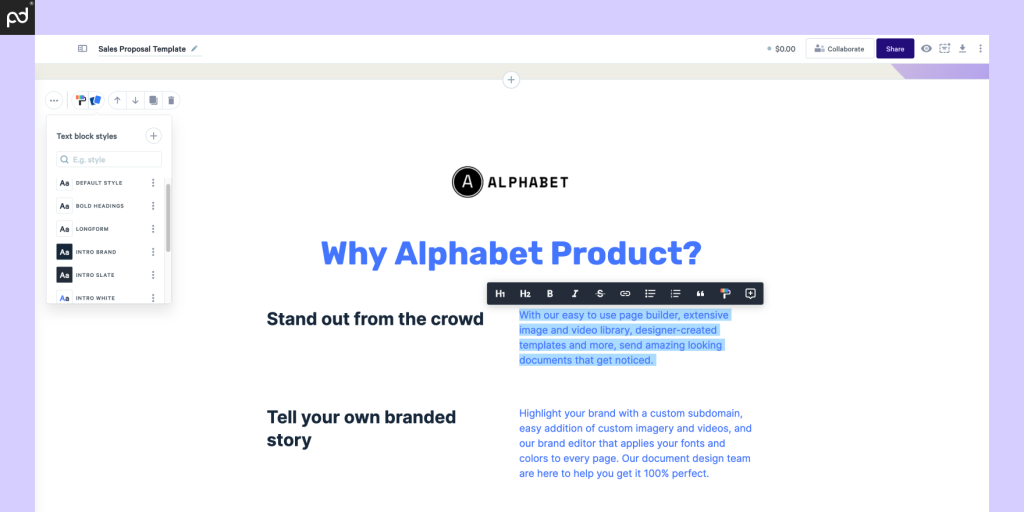
Qwilr, like Proposify, offers the option to either start from scratch or use their proposal templates, all of which can be built into a perfect, professional proposal.
You can even template the process so that proposal creation is fast and easy.
Regarding analytics: Qwilr gives you a variety of unique insights.
The platform allows you to see the total number of views, the time spent on an individual block, where users clicked, and more.
The downside to all this? Qwilr excels at building web pages, but there can be issues with formatting if you need to convert your landing page to a PDF. The option is there, but it isn’t always seamless.
The platform also doesn’t allow you to upload and import Google Docs or Microsoft Word documents, leading some users to report that they would rather go with a standard PDF proposal.
3. GetAccept
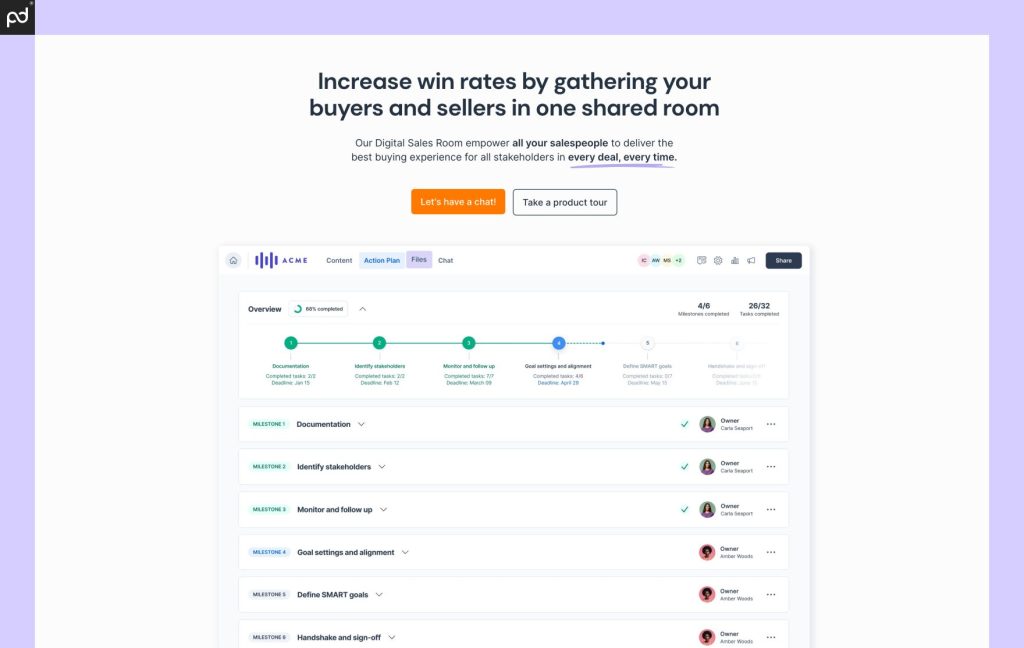
Our rating: 4.7/5
Pricing: eSign ($25/month); Deal Room ($39/month); Contract Room ($49/month); Full Suite ($79/month). Enterprise solutions available. Pricing based on monthly commitment.
Free trial? Yes; 14 days.
Great fit for: Teams looking for software tools to manage their end-to-end sales process.
GetAccept is a great all-in-one proposal software for sales teams of all sizes.
It’s equipped with the tools you’ll need to create proposals from scratch, manage them through their full lifecycle, and stay closely connected with your customers along the way.
This is important to note because, while document creation plays a role in the GetAccept toolkit, the platform is built to offer a more robust (and complete!) selling experience for reps and customers alike.
| Feature | Proposify | GetAccept |
|---|---|---|
| Proposal tools | Drag & drop | Drag & drop |
| E-signing | ✓ | ✓ |
| Templates | ✓ | ✓ |
| Content library | ✓ | ✓ |
| Custom domain | ✓ | X |
| Custom branding | ✓ | ✓ |
| Payment gateways | Limited | $ |
| CRM integrations | 2 | 5 |
| Document analytics | ✓ | ✓ |
| API access | X | $ |
| Customer Support | ||
| Email / ticketing | ✓ | ✓ |
| 24/7 chat | X | ✓ |
| Phone | $ | X |
| Success manager | $ | $ |
| Onboarding services | $ | X |
Major differences
- Where Proposify is focused entirely on proposal creation, GetAccept provides tools for the entire selling process.
- Proposify’s document builder is more sophisticated than what GetAccept provides.
- GetAccept offers more integrations at higher tiers, but you’ll need to pay extra for them if you’re not on an enterprise plan.
Proposify vs GetAccept
If you’re comparing Proposify and GetAccept (full review here!), you’ll quickly notice that the products share some overlap in their intended use case and purpose.
That’s because GetAccept is one of the few proposal platforms (along with Proposify and PandaDoc) that allows you to create documents from scratch inside an online editor.
The GetAccept editor comes with a battery of tools to help you stay connected to your customer. You can add images and text blocks, create customized proposals using saved templates, and even personalize content with built-in video tools.
After you send your content to customers for review, you’ll even be able to monitor access using document analytics and live chat with clients to answer questions in real-time to keep the deal moving forward.
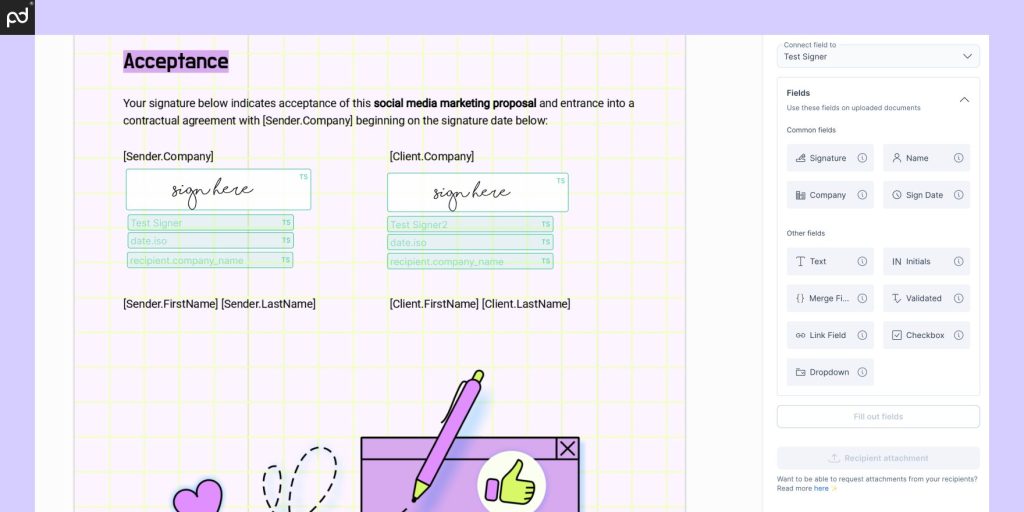
GetAccept also offers solutions to carry your deal even further after proposals and contracts are dispatched.
Every opportunity is attached to a deal room, which serves as a repository for your sales documents, supporting information, and stakeholder communications.
This end-to-end workflow allows you to completely eliminate a variety of tools, from e-signing solutions like DocuSign all the way to meeting software and contract storage.
This sets the platform apart from Proposify, which is primarily focused on the design and creation of sales documentation.
While, comparatively, the Proposify editor brings more to the table in the document design process, GetAccept offers a wider range of tools to manage more of the sales process.
There are a few downsides to consider, especially on lower-tiered plans, where you’ll see reduced functionality around integrations, branding, and analytics.
However, thanks to the wide selection of pricing options, you can likely find a plan with a feature set that suits your unique needs.
In some ways, GetAccept goes overboard here. Counting enterprising pricing options, you’ll have seven bundle options to choose from.
That’s notable, particularly in an industry where most companies offer two or three options prior to enterprise-level pricing.
At the same time, this approach provides more flexibility than what you’ll see with Proposify, which offers two very similar price points ($35 and $49 per month, respectively) before jumping to a multi-seat enterprise plan at $650/month.
4. Nusii
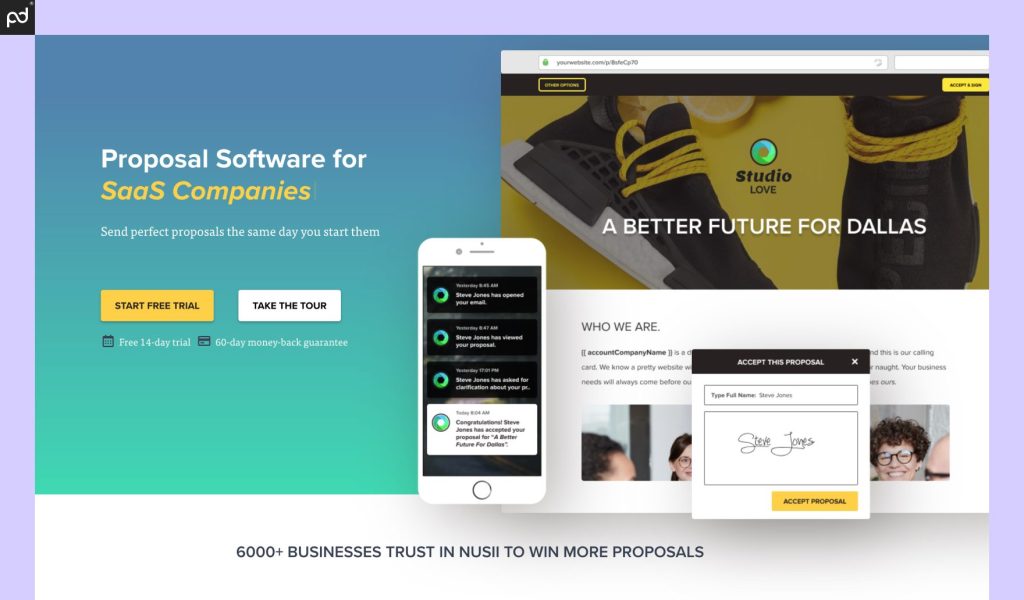
Our rating: 4.4/5
Pricing: Freelance ($29/month); Agency ($49/month); Business ($129/month). Pricing based on monthly commitment.
Free trial? Yes; 14 days.
Great fit for: Teams looking for streamlined proposals that are both easy to build and easy to read.
Nusii positions itself as a web-based proposal builder designed to replace Word, InDesign, and PDF with a simple-to-use browser interface.
The platform offers branding options, a from-scratch document editor, automation through templates and recyclable content, and a host of integrations with CRMs, payment gateways, and productivity tools.
The goal of all this? To streamline your proposal workflow so that you can get proposals out the door as quickly as possible.
The block-based builder and formatting tool makes it easy to style your proposals with text, images, and video.
You’ll also have access to interactive pricing tools so that you can offer flexible solutions to customers.
All of that, combined with an e-signing solution and instant notifications, gives you everything you need to build proposals at lightning speed.
| Feature | Proposify | Nusii |
|---|---|---|
| Proposal tools | Drag & drop | Drag & drop |
| E-signing | ✓ | ✓ |
| Templates | ✓ | ✓ |
| Content library | ✓ | ✓ |
| Custom domain | ✓ | ✓ |
| Custom branding | ✓ | ✓ |
| Payment gateways | Limited | ✓ |
| CRM integrations | 2 | 4 |
| Document analytics | ✓ | ✓ |
| API access | X | ✓ |
| Customer Support | ||
| Email / ticketing | ✓ | ✓ |
| 24/7 chat | X | X |
| Phone | $ | X |
| Success manager | $ | X |
| Onboarding services | $ | X |
Major differences
- Proposify’s document editor offers more granularity and flexibility than the Nusii toolkit.
- Nusii caters more to freelancers and solopreneurs while Proposify is largely aimed at small businesses and teams.
- While Proposify caps the number of unique opens for a document, Nusii caps the number of proposals that can be sent at a given time.
Proposify vs Nusii
Both Nusii and Proposify are designed to fill a similar niche in your sales process. You won’t need both, and which platform is the better fit will come down to your preferences around design, customization, and branding.
Unfortunately for Nusii, Proposify has a pretty clear edge here.
Nusii proposals largely consist of an image or video at the top, a collection of text interspersed with various media, a pricing table, and a workflow for readers to either accept or reject the proposal.
While you can use the built-in editor to add some layers of complexity, you’ll be limited in scope by the design capabilities of the software at hand.
The result? Every Nusii proposal looks roughly the same.
You can change a few things here and there, but like so many Proposify competitors, Nusii doesn’t really compare to the breadth of design and layout options that Proposify offers to its customers.
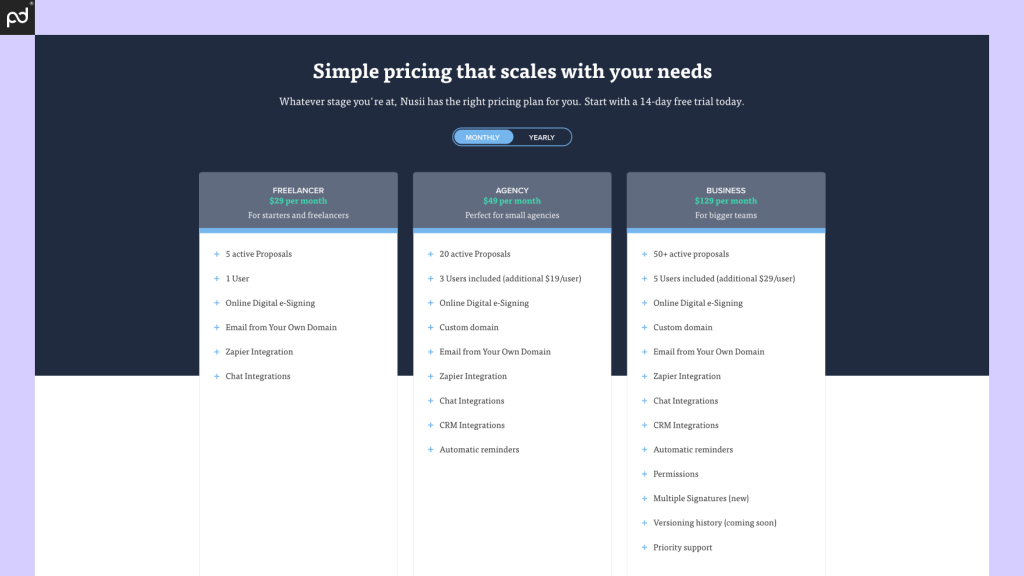
However, design isn’t the have-all/end-all of sales documentation.
Nusii proposals are serviceable. They get the job done, look nice, and don’t take hours of painstaking labor to create.
For teams who want to make a good first impression but aren’t interested in falling into the weeds when it comes to layouts, Nusii is a great choice.
Outside of design and layout, Nusii offers the standard fare of features and solutions that you see in most proposal builders we’ve covered.
You can add custom branding solutions (including a custom domain), integrate with a selection of CRMs like HubSpot and PipeDrive, connect with various productivity tools, and more.
One important thing to note is that Nusii’s Agency plan runs $49/month and includes three users, meaning that you can secure a proposal software solution for a small sales team at a much lower cost than a Proposify subscription.
Especially for small teams who need something fast, simple, and affordable, Nusii does a great job striking a balance on all points.
Of course, there may be other competitors to consider, as well.
5. RelayTo
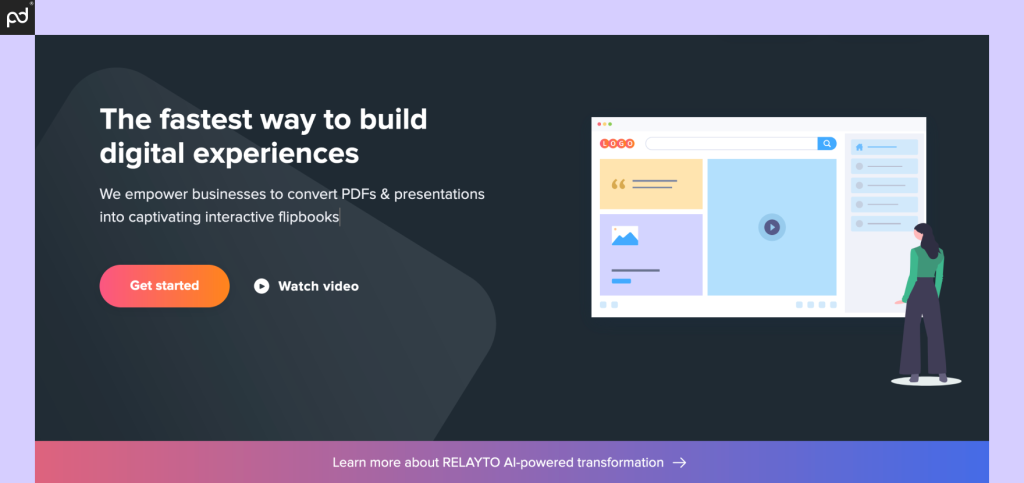
Our rating: 4.2/5
Pricing: Pro ($65/month); Team ($800/month); Business ($2700/month). Pricing based on annual commitment. Enterprise plans also available.
Free trial? Yes; 14 days.
Great fit for: Teams who want to build an interactive experience from their digital documents.
RelayTo is a sales engagement platform designed to streamline and automate the sales outreach process.
The platform specializes in the creation of personalized, multi-touch sequences that nurture leads and drive engagement.
Onboard analytics and reporting provide valuable insights into campaign performance, allowing sales professionals to refine their strategies and improve results.
With its user-friendly interface and robust automation capabilities, RelayTo empowers sales teams to focus on building relationships and closing deals, rather than getting bogged down in manual tasks.
| Feature | Proposify | RelayTo |
|---|---|---|
| Proposal tools | Drag & drop | Compiler |
| E-signing | ✓ | X |
| Templates | ✓ | X |
| Content library | ✓ | ✓ |
| Custom domain | ✓ | ✓ |
| Custom branding | ✓ | ✓ |
| Payment gateways | Limited | $ |
| CRM integrations | 2 | 2 |
| Document analytics | ✓ | ✓ |
| API access | X | $ |
| Customer Support | ||
| Email / ticketing | ✓ | ✓ |
| 24/7 chat | X | ✓ |
| Phone | $ | X |
| Success manager | $ | ✓ |
| Onboarding services | $ | X |
Major differences
- At its core, RelayTo is a presentation tool focused on generating personalized experiences while Proposify is dedicated to proposal creation and management.
- Proposify offers proposal generation tools, but proposals presented via RelayTo would need to be created off-platform.
- While Proposify has a steeper learning curve, we found RelayTo’s interface clunky and tedious during testing.
Proposify vs RelayTo
RelayTo and Proposify have some overlap where sales enablement and outreach are concerned, but they have distinct focuses and capabilities.
RelayTo is primarily a sales engagement platform, specializing in personalized outreach across multiple channels and formats.
Using RelayTo, it’s possible to create ebooks, brochures, infographics, presentations, and more. The platform aims to be a place where you can share and distribute content, then use onboard analytics to track engagement.
On the other hand, Proposify is a dedicated proposal software platform focused on creating, sending, and managing professional proposals.
Users can build documents from scratch, prompt viewers to electronically sign documents, and more. Presentation is only one aspect of its use case.
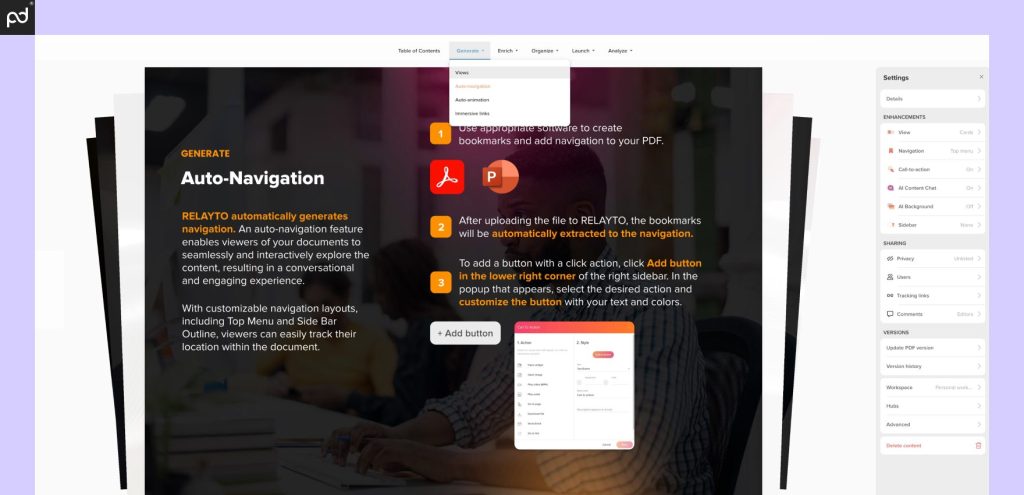
While these two platforms see vastly different use cases, there is some overlap here.
Both platforms offer integrations with popular CRMs like HubSpot and Salesforce.
Both track user engagement and provide a wide selection of presentation opportunities for deals, proposals, and data.
However, RelayTo leans heavily toward interactivity, offering tools like animation, presentation pop-ups, video narration, and even on-page SEO functionality.
The tool offers little in the way of nuts-and-bolts proposal creation or contract management.
With that in mind, it’s possible for both of these tools to coexist within the same tech stack. Proposify could (feasibly) be used to generate proposals while RelayTo is used to present the data.
However, given Proposify’s sharing and engagement capabilities, such a workflow might seem redundant.
Ultimately, the choice between RelayTo and Proposify depends on your specific needs and priorities.
If your focus is on improving engagement around content (including proposals), RelayTo may provide an avenue to accomplish those goals.
On the other hand, if you’re aiming to create professional proposals and track their performance, Proposify could be the more suitable choice.
6. DealHub
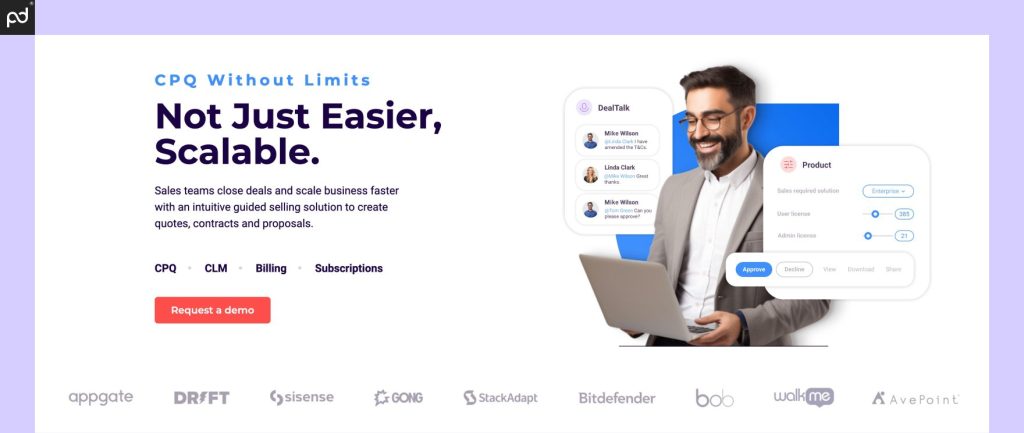
Our rating: 4.5/5
Pricing: Custom-built by sales team.
Free trial? Demo only.
Who is this for: Organizations seeking tools to boost their selling process.
DealHub is a great CPQ software for teams who want to create an immersive experience for customers during every stage of the sales process.
This platform is equipped with tools to streamline sales workflows and to help all teams and stakeholders operate from a single source of truth during the sales process.
| Feature | Proposify | DealHub |
|---|---|---|
| Proposal tools | Drag & drop | Compiler |
| E-signing | ✓ | ✓ |
| Templates | ✓ | ✓ |
| Content library | ✓ | ✓ |
| Custom domain | ✓ | X |
| Custom branding | ✓ | ✓ |
| Payment gateways | Limited | ✓ |
| CRM integrations | 2 | 6 |
| Document analytics | ✓ | ✓ |
| API access | X | ✓ |
| Customer Support | ||
| Email / ticketing | ✓ | ✓ |
| 24/7 chat | X | X |
| Phone | $ | ✓ |
| Success manager | $ | ✓ |
| Onboarding services | $ | ✓ |
Major differences
- While Proposify focuses on document creation, DealHub offers a suite of selling tools that includes document generation capabilities.
- DealHub focuses heavily on subscriptions and recurring payments while Proposify is set up for single transactions.
- Overall, DealHub offers a toolkit that targets mid-market and larger organizations. Proposify is geared more toward small- to medium-sized companies.
Proposify vs DealHub
Dealhub bills itself as more of a collaborative platform than a document creation tool. And, at some level, that’s probably true.
Where Proposify is interested in helping you create content to help you close deals, Dealhub tries to act as a single source of truth to put all deal-related information in a single place.
This includes discovery sessions, proposal content, quoting, buying, and post-deal negotiations.
There is a surprising amount of overlap between these two products because, like Proposify, DealHub offers sales proposals and e-signing tools.
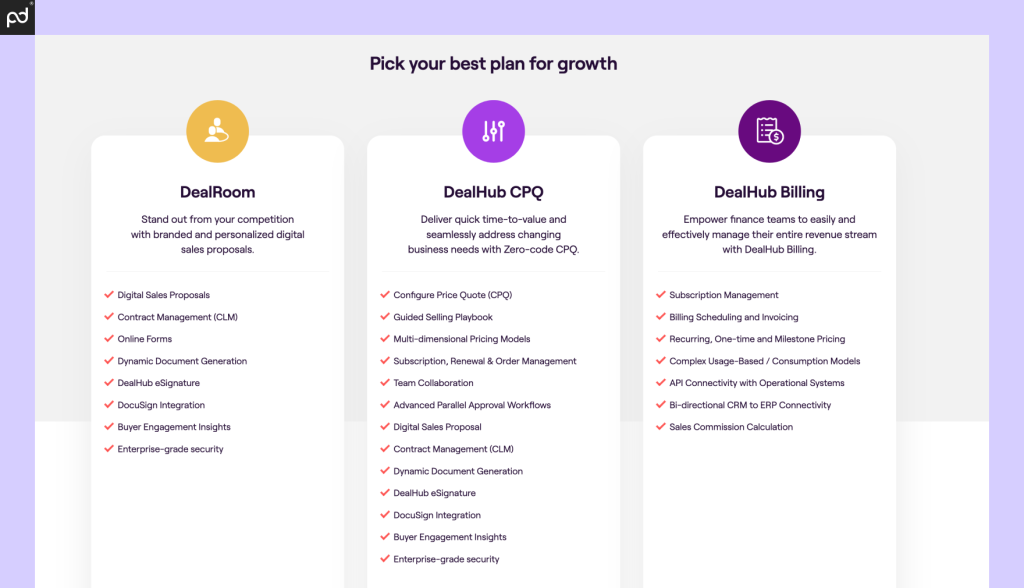
Speaking purely in terms of document creation, Proposify outshines DealHub’s capabilities. DealHub offers document generation, allowing users to set up templates and input information to receive formatted proposals.
However, document generation lacks the granular control that you’ll see in an open-ended editor like Proposify.
On the other hand, DealHub includes tools for guided selling, subscription-based selling, and streamlining the CPQ process.
If you’re looking for a Proposify alternative that could potentially replace large chunks of your sales process, DealHub might be worth exploring.
However, you may also be taking a step back when it comes to true document generation by offloading that work to a traditional word processor.
If that doesn’t sound interesting to you, DealHub probably isn’t the way forward despite its arsenal of features.
7. Oneflow
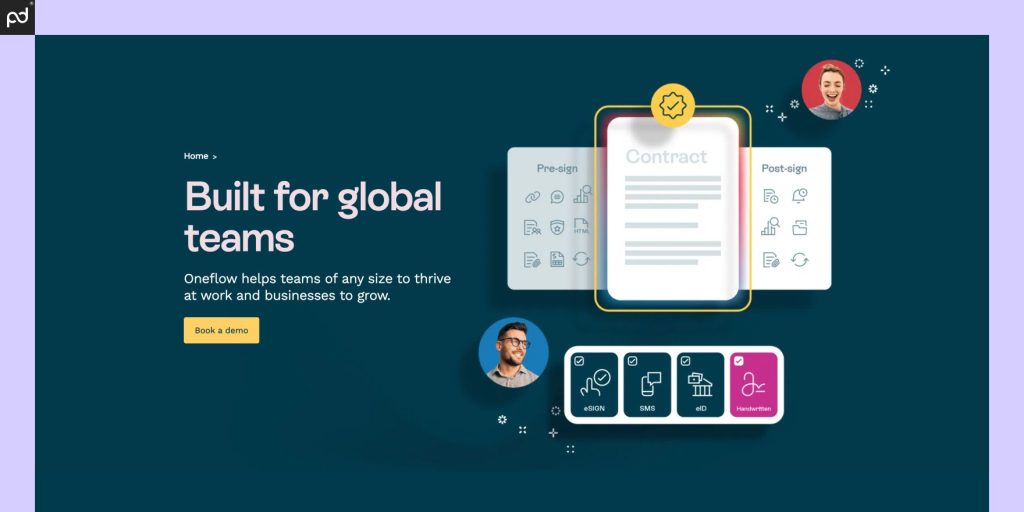
Our rating: 4.6/5
Pricing: Essentials ($17/month); Business ($45/month). Pricing based on annual commitment. Enterprise solutions also available.
Free trial? Yes; 14 days.
Great fit for: Teams who want to build flexible, digital contracts in one place.
Oneflow is a comprehensive contract lifecycle management platform that revolutionizes the way businesses handle contracts.
By centralizing all contract-related activities in one place, Oneflow eliminates manual tasks, reduces errors, and accelerates the contract process from creation to signature.
With its intuitive interface and collaboration features, Oneflow fosters seamless communication and negotiation between parties, ensuring a smooth and efficient experience.
The platform’s analytics and reporting capabilities (similar to what PandaDoc offers) provide valuable insights into contract performance, allowing businesses to identify bottlenecks and optimize their contract workflows.
| Feature | Proposify | Oneflow |
|---|---|---|
| Proposal tools | Drag & drop | Drag & drop |
| E-signing | ✓ | ✓ |
| Templates | ✓ | ✓ |
| Content library | ✓ | ✓ |
| Custom domain | ✓ | X |
| Custom branding | ✓ | ✓ |
| Payment gateways | Limited | X |
| CRM integrations | 2 | 12 |
| Document analytics | ✓ | ✓ |
| API access | X | ✓ |
| Customer Support | ||
| Email / ticketing | ✓ | ✓ |
| 24/7 chat | X | ✓ |
| Phone | $ | $ |
| Success manager | $ | $ |
| Onboarding services | $ | $ |
Major differences
- Proposify focuses primarily on proposal creation while Oneflow covers the entire contract lifecycle.
- Oneflow emphasizes real-time collaboration and e-signatures while Proposify prioritizes design and visuals.
- Though Oneflow offers better options for CRM integration, only Proposify provides a payment solution.
Proposify vs Oneflow
Oneflow and Proposify are both aimed at streamlining the sales process, but they cater to different funnel stages and offer distinct functionalities.
Oneflow is a comprehensive contract lifecycle management platform that goes beyond proposal creation.
It focuses on the entire contract journey, from drafting and negotiation to signing and renewal. This platform’s strength lies in its collaborative real-time editing, interactive contracts, and seamless integrations with other business systems, making it ideal for complex sales cycles that involve legal and financial teams.
Proposify specializes in proposal creation and management. It excels in crafting visually appealing, interactive proposals with customizable document templates, pricing tables, and e-signature capabilities.
Proposify’s strength lies in its user-friendly interface, design flexibility, and proposal analytics, making it a valuable tool for sales teams looking to create persuasive proposals and track their performance.
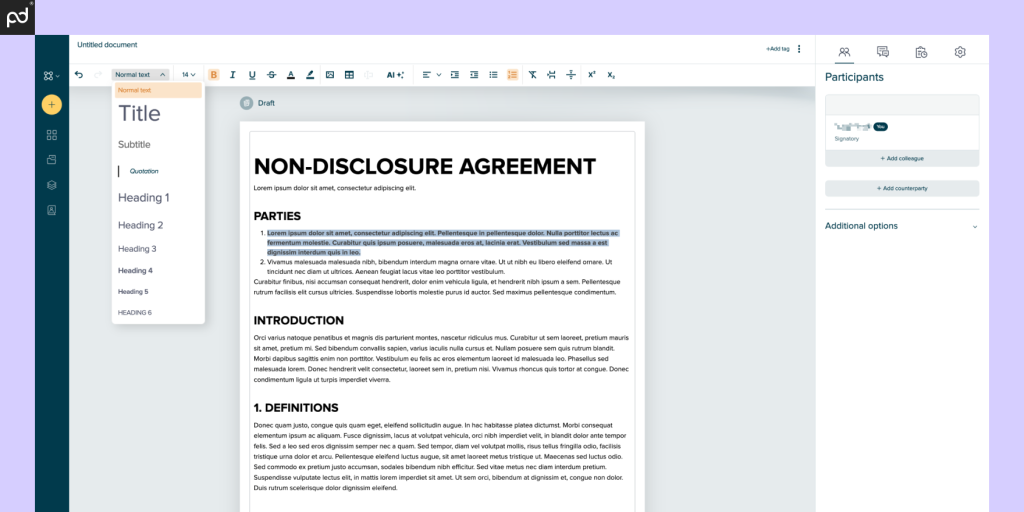
While both platforms offer integrations with CRM systems, Oneflow’s focus is on integrating with broader business systems for end-to-end contract management while Proposify primarily integrates with sales-focused tools to enhance proposal effectiveness.
In terms of target audience, Oneflow is a better fit for businesses with complex sales cycles that require collaboration across multiple departments and a focus on the entire contract lifecycle. Proposify, on the other hand, is ideal for sales teams looking to create impressive proposals, track their engagement, and streamline the proposal process.
Ultimately, the choice between Oneflow and Proposify depends on your specific needs. If your priority is comprehensive contract lifecycle management with seamless collaboration, Oneflow is a strong contender.
If your focus is on creating and managing visually compelling proposals, Proposify is likely the better choice.
8. Anchor
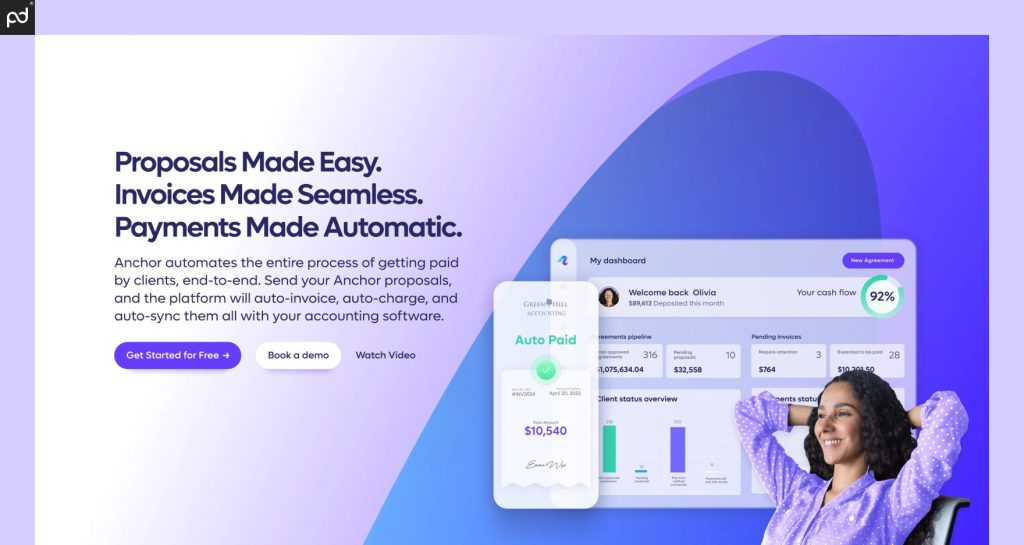
Our rating: 4.2/5
Pricing: $5 per payment received.
Free trial? This platform is free to use.
Great fit for: Organizations with subscription-based and recurring pricing who can leverage automatic billing to their advantage.
Anchor is an automated billing and collections platform designed to simplify and streamline the payment process for everyone from freelancers to corporate enterprises.
By automating invoice creation, payment reminders, and collections, Anchor eliminates the need for manual intervention, saving time and reducing errors.
The platform’s intuitive interface allows users to easily create professional invoices, track payments, and manage client relationships.
With its focus on automation and efficiency, Anchor empowers businesses to get paid faster and improve their cash flow.
| Feature | Proposify | Anchor |
|---|---|---|
| Proposal tools | Drag & drop | Compiler |
| E-signing | ✓ | X |
| Templates | ✓ | ✓ |
| Content library | ✓ | Limited |
| Custom domain | ✓ | X |
| Custom branding | ✓ | ✓ |
| Payment gateways | Limited | ✓ |
| CRM integrations | 2 | Zapier |
| Document analytics | ✓ | X |
| API access | X | X |
| Customer Support | ||
| Email / ticketing | ✓ | ✓ |
| 24/7 chat | X | X |
| Phone | $ | X |
| Success manager | $ | X |
| Onboarding services | $ | X |
Major differences
- While Proposify allows for custom document generation, Anchor largely disregards this process in favor of plan-based proposal generation.
- Teams using Proposify will follow a more traditional e-signing and a one-time payment capture process.
- Anchor tries to set up automatic billing during the first interaction to create a set-it-and-forget-it system of recurring payments.
Proposify vs Anchor
Anchor and Proposify serve distinct purposes within the broader business landscape, catering to different financial and sales needs.
Anchor is an automated billing and collections platform designed to simplify the invoicing and payment process.
It focuses on automating recurring billing, sending payment reminders, and facilitating seamless online payments.
Meanwhile, Proposify aims to help teams create, send, and manage professional sales proposals.
The customizable templates, interactive pricing tools, and e-signature capabilities are designed to help teams close deals more effectively.
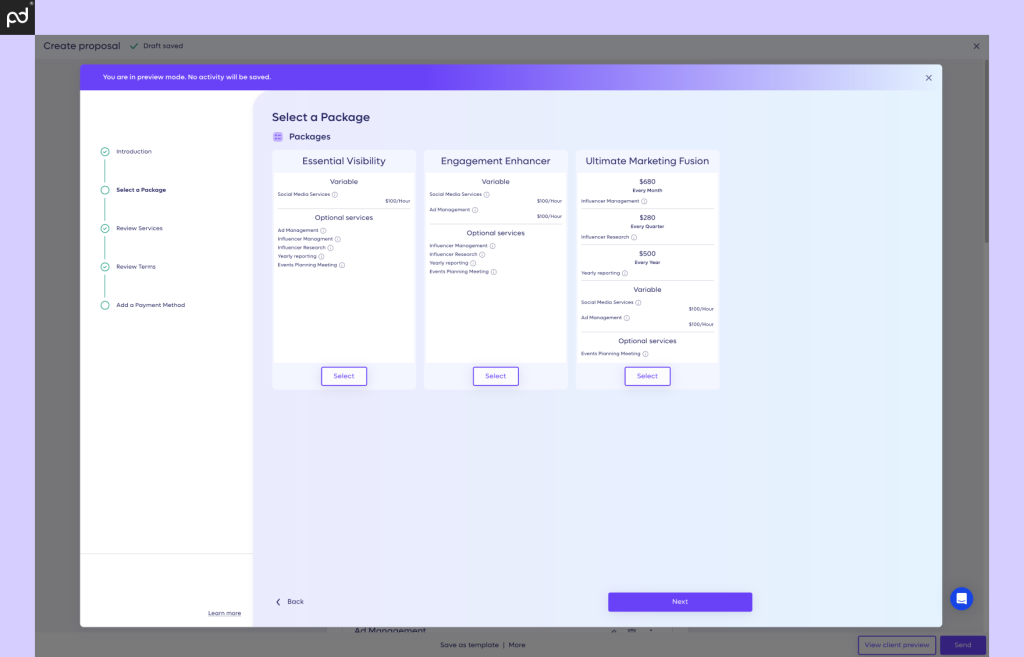
While both platforms contribute to revenue generation, they address different stages of the process.
Anchor focuses on ensuring timely payments and efficient financial management after a deal is closed, while Proposify focuses on creating compelling proposals to win deals in the first place.
In terms of target audience, Anchor is ideal for businesses and freelancers seeking to automate their billing and collection processes, reducing administrative overhead and improving cash flow.
This contrasts Proposify’s approach, which is best suited for sales teams looking to create professional, engaging proposals and track their effectiveness to close deals faster.
The better choice in this scenario will come down to your pricing structure and ability to onboard customers to recurring payments.
If your business model doesn’t lend itself to retainers or subscription-based services, Anchor may not have much to offer.
9. Fresh Proposals
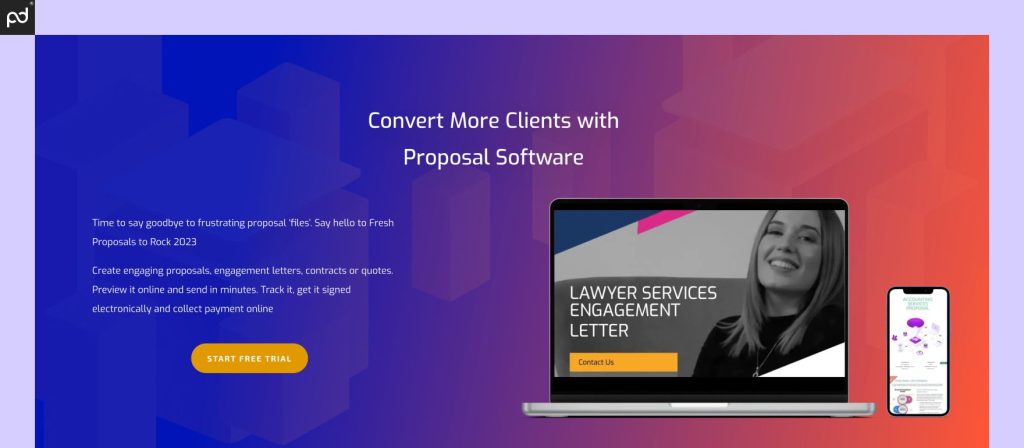
Our rating: 4.1/5
Pricing: Starters ($15/month); Professional ($30/month); Business ($59/month).
Free trial? Yes; 14 days.
Great fit for: Teams looking for an online document builder who aren’t worried about sophisticated CRM integrations.
Fresh Proposals is a user-friendly proposal software designed to help businesses create, send, and manage professional-looking proposals with ease.
By streamlining the proposal process, Fresh Proposals eliminates the need for time-consuming manual formatting and enables sales teams to focus on closing deals.
The platform offers a range of customizable templates, interactive pricing tools, and e-signature capabilities, ensuring a seamless and efficient proposal experience.
With its built-in analytics and tracking features, Fresh Proposals provides valuable insights into proposal performance, empowering businesses to make data-driven decisions and improve their sales success rates.
| Feature | Proposify | Fresh Proposals |
|---|---|---|
| Proposal tools | Drag & drop | Drag & drop |
| E-signing | ✓ | ✓ |
| Templates | ✓ | ✓ |
| Content library | ✓ | ✓ |
| Custom domain | ✓ | ✓ |
| Custom branding | ✓ | ✓ |
| Payment gateways | Limited | ✓ |
| CRM integrations | 2 | 3 |
| Document analytics | ✓ | ✓ |
| API access | X | X |
| Customer Support | ||
| Email / ticketing | ✓ | ✓ |
| 24/7 chat | X | X |
| Phone | $ | X |
| Success manager | $ | X |
| Onboarding services | $ | X |
Major differences
- Overall, Proposify is a more robust solution than Fresh Proposals, offering a better document editor and more extensive integrations.
- Fresh Proposals is more affordable, making it a great fit for small businesses and startups.
- While Proposify offers more by way of design, Fresh Proposals emphasizes simplicity and ease of use.
Proposify vs Fresh Proposals
Fresh Proposals and Proposify are both proposal software solutions designed to streamline the creation and management of sales proposals, but they differ in their approach and target audience.
Fresh Proposals positions itself as a user-friendly and affordable alternative to Proposify, offering a comprehensive suite of features for creating, sending, and tracking proposals.
The platform emphasizes its intuitive interface, customizable templates, and interactive elements, making it easy for businesses of all sizes to create professional-looking proposals. Fresh Proposals also boasts features like e-signatures, payment integration, and client collaboration tools, providing a seamless proposal experience.
Proposify is a more established player in the market, catering to businesses with larger sales teams and more complex proposal requirements.
It offers a wider range of advanced features, including customizable branding, content libraries, and CRM integrations.
Proposify’s strength lies in its robust functionality, extensive integrations, and detailed analytics, making it a powerful tool for sales teams looking to scale their proposal process.
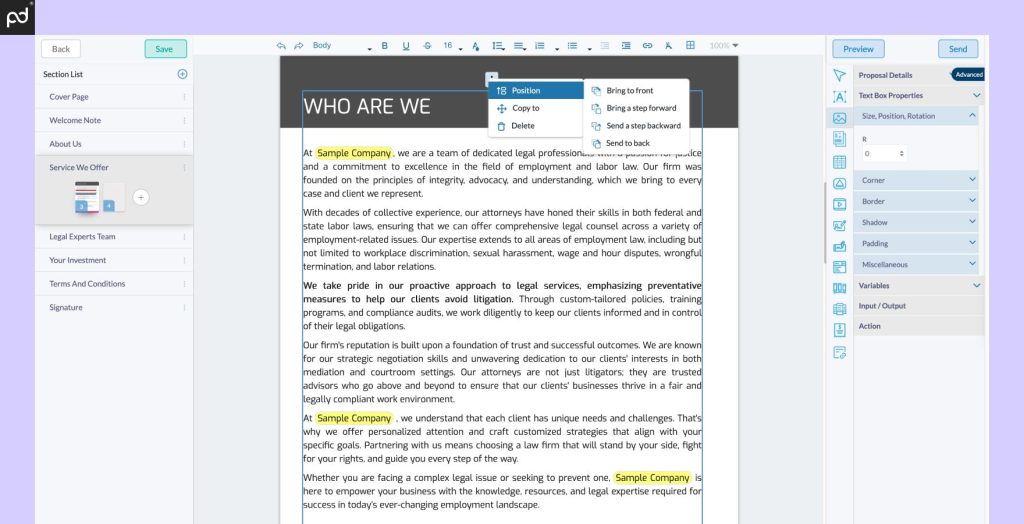
Both platforms offer features like proposal templates, e-signatures, and analytics, but Fresh Proposals emphasizes its affordability and ease of use, while Proposify focuses on its advanced features and scalability.
In terms of target audience, Fresh Proposals is ideal for freelancers and smaller organizations who need a user-friendly and cost-effective proposal solution.
Proposify, with its more advanced features and higher price point, is generally better-suited to mid market and larger businesses with dedicated sales teams and more complex proposal needs.
Ultimately, the choice between Fresh Proposals and Proposify depends on your specific requirements and budget.
If you’re looking for an easy-to-use and affordable solution with all the essential features, Fresh Proposals is a strong contender.
However, if you need a more comprehensive and scalable platform with advanced design features and integrations, Proposify is likely to be a better fit.
10. Ignition
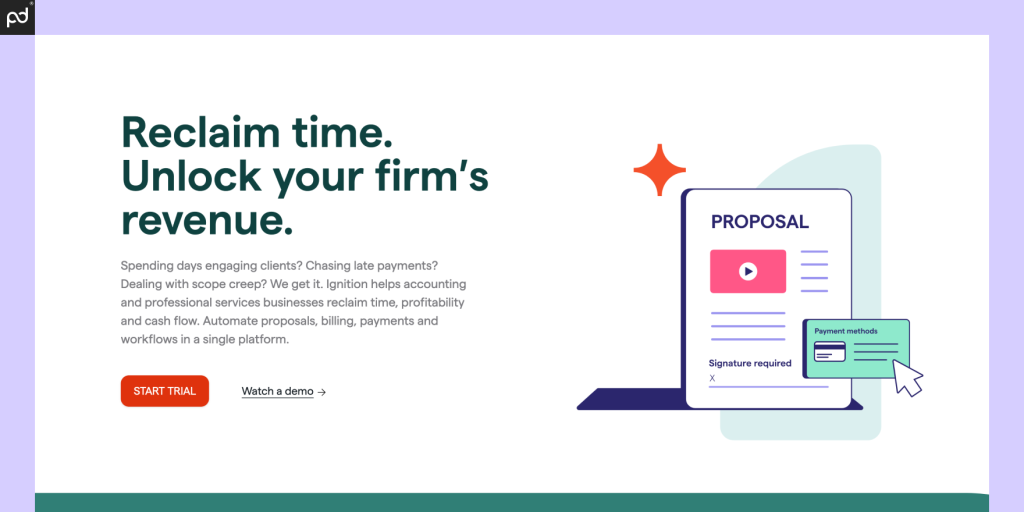
Our rating: 4.4/5
Pricing: Core ($99/month); Pro ($199/month); Pro+ ($499/month). All pricing based on annual commitment.
Free trial? Yes; 14 days.
Great fit for: Medium and larger organizations interested in turnkey document automation.
Ignition is a client engagement and commerce platform designed to streamline the way professional service businesses onboard clients, create proposals, and manage payments.
By automating repetitive tasks and centralizing client interactions, Ignition empowers businesses to deliver a seamless and professional client experience from the initial engagement to project completion.
The platform’s intuitive interface allows users to easily create customized proposals, set up payment schedules, and track project progress.
With its focus on efficiency and client satisfaction, Ignition enables professional service businesses to grow their revenue and build stronger client relationships.
| Proposify | Proposify | Ignition |
|---|---|---|
| Proposal tools | Drag & drop | Compiler |
| E-signing | ✓ | Limited |
| Templates | ✓ | ✓ |
| Content library | ✓ | Limited |
| Custom domain | ✓ | X |
| Custom branding | ✓ | ✓ |
| Payment gateways | Limited | ✓ |
| CRM integrations | 2 | 0 |
| Document analytics | ✓ | X |
| API access | X | X |
| Customer Support | ||
| Email / ticketing | ✓ | ✓ |
| 24/7 chat | X | X |
| Phone | $ | X |
| Success manager | $ | X |
| Onboarding services | $ | ✓ |
Major differences
- Proposify is solely focused on proposals, while Ignition offers a broader suite of client management tools.
- When designing proposals, Proposify offers much more granularity and customization. Ignition proposals are a very turnkey / automated ordeal.
- Ignition is primarily focused on client lifecycle management, of which proposals are a small part.
Proposify vs Ignition
Ignition and Proposify are both client-centric platforms that streamline aspects of the sales and service process, but they cater to distinct professional needs with differing functionalities.
Overall, Ignition aims to simplify the onboarding process, manage client interactions, and streamline financial transactions for service-based businesses.
The platform facilitates the creation of visually appealing proposals, automates engagement letters and client agreements, and enables efficient billing and payment collection.
This is a functionally different approach than what Proposify offers, where emphasis is placed on creating, managing, and customizing sales proposals in an effort to drive conversions.
With Proposify, you’ll have more tools to win more deals through persuasive and data-driven proposals, including a drag-and-drop builder and document analytics.
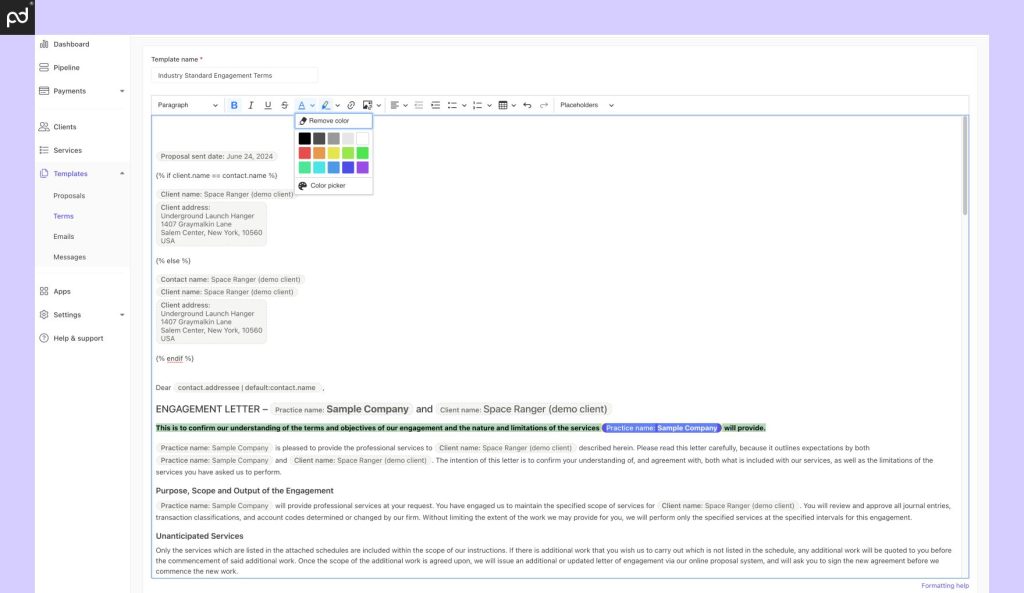
While both platforms contribute to a smoother client experience, they address different stages of the customer journey.
Ignition focuses on the initial engagement, onboarding, and financial aspects of service delivery, while Proposify concentrates on the proposal stage, aiming to secure the deal.
In terms of target audience, Ignition is ideal for professional service businesses like accountants, consultants, and agencies seeking to streamline client onboarding and financial management. Meanwhile, Proposify is best suited for sales teams across various industries who prioritize creating visually appealing, high-converting proposals.
When choosing between these two, your choice may come down to your business model and how you want to interact with clients.
If your priority is to streamline client engagement, automate service agreements, and manage billing efficiently, Ignition is the more suitable option.
However, if creating persuasive proposals it a touchstone of your brand and client experience, Proposify offers a better suite of tools to get the job done.
Choosing the best Proposify competitors
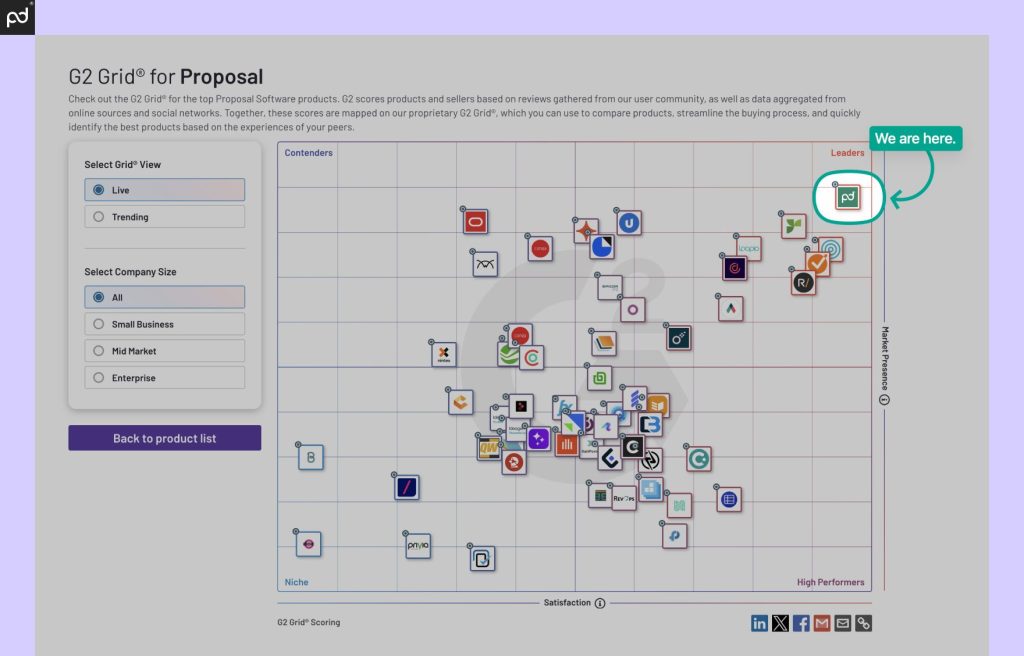
To identify the top Proposify competitors, we turned to the G2 Grid, a measuring tool for comparing software solutions based on user reviews and market presence.
Focusing on the “Proposal Software” category, we filtered results to match specific needs and preferences. By analyzing user reviews, satisfaction ratings, and market presence scores, we pinpointed the highest-ranking alternatives.
These competitors were then thoroughly assessed for their unique strengths and weaknesses, ensuring a comprehensive evaluation before selecting the best fit for your specific requirements.
This rigorous process leveraged the collective wisdom of G2’s user community to uncover the most promising Proposify alternatives in the market.
Build better proposals with PandaDoc
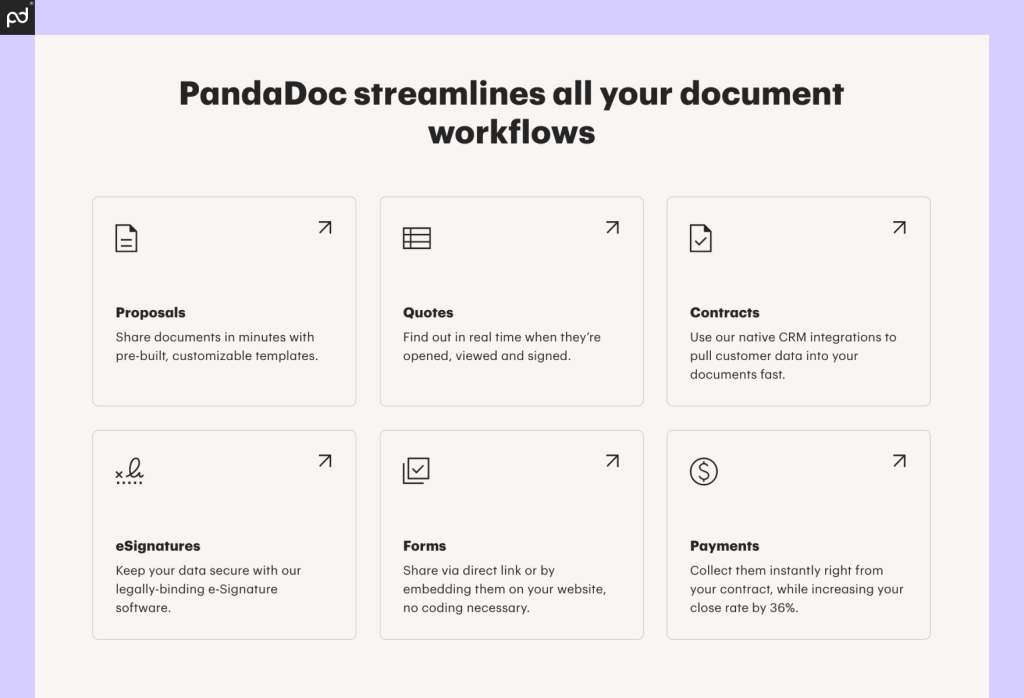
Crafting compelling proposals is essential for winning deals and driving business growth. With PandaDoc, you can elevate your proposals from ordinary to extraordinary.
Our intuitive platform streamlines the entire proposal process, from creation to closing, empowering your sales team to create professional, personalized proposals that leave a lasting impression.
Here are a few key features that set PandaDoc apart:
- Intuitive document builder. Easily create polished, professional proposals with our drag-and-drop editor and customizable templates.
- Seamless e-signing workflow. Securely capture legally binding signatures in minutes, speeding up the closing process.
- Robust integrations. Connect PandaDoc with your existing CRM, payment gateways, and other essential tools for a unified workflow.
Say goodbye to tedious manual processes and embrace a streamlined, efficient proposal workflow with PandaDoc!
Don’t just take our word for it.
Experience the power of PandaDoc firsthand by signing up for a 14-day free trial or scheduling a personalized demo today.
Unlock the potential of your proposals and take your sales game to the next level.
Disclaimer
PandaDoc is not a law firm, or a substitute for an attorney or law firm. This page is not intended to and does not provide legal advice. Should you have legal questions on the validity of e-signatures or digital signatures and the enforceability thereof, please consult with an attorney or law firm. Use of PandaDoc services are governed by our Terms of Use and Privacy Policy.
Originally published May 6, 2019, updated August 15, 2024
